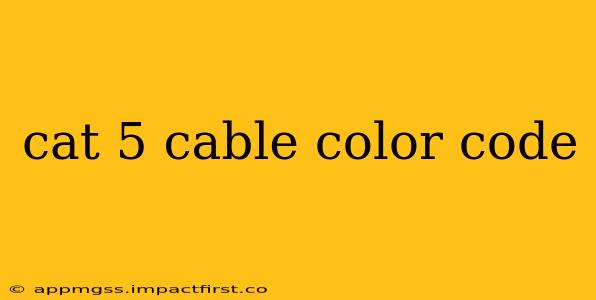Understanding the Cat 5 cable color code is crucial for anyone working with networking infrastructure. This seemingly simple system of colored wires dictates how data travels across your network, impacting speed and reliability. This guide will break down the Cat 5 cable color code, addressing common questions and providing you with the knowledge to confidently work with these cables.
What is the standard Cat 5 cable color code?
The standard TIA/EIA 568A and TIA/EIA 568B color codes define the arrangement of wires within a Cat 5 cable. Both standards use the same eight wires, but their order differs. This difference is important, as you must use the same standard at both ends of the cable for it to work correctly. Inconsistency will lead to connection failures.
TIA/EIA 568A:
- Orange/White
- Orange
- Green/White
- Blue
- Blue/White
- Green
- Brown/White
- Brown
TIA/EIA 568B:
- Green/White
- Green
- Orange/White
- Blue
- Blue/White
- Orange
- Brown/White
- Brown
Notice the difference? The orange and green pairs are swapped between the two standards. Choosing one standard and sticking with it consistently throughout your network is essential.
What's the difference between 568A and 568B?
The primary difference between 568A and 568B lies in the arrangement of the orange and green wire pairs. There's no inherent performance advantage to one standard over the other; the key is consistency. Many installers favor one standard over the other due to personal preference or established company practices. The important thing is that both ends of the cable use the same standard.
How important is the Cat 5 cable color code order?
The color code is absolutely critical. It dictates which wire carries which signal, ensuring that data is transmitted and received correctly. Incorrect wiring will result in a non-functional or poorly performing network connection. Even a single misplaced wire can cause significant problems.
What happens if I get the Cat 5 cable color code wrong?
If the Cat 5 cable color code is incorrect, you'll likely experience connectivity issues, slow speeds, data loss, or complete connection failure. The network may not function at all, requiring you to troubleshoot and rewire the cable correctly.
Can I use a Cat 5 cable for internet?
Yes, Cat 5 cables can be used for internet connections, but they are generally considered outdated. While they can handle internet speeds, newer standards like Cat 5e, Cat 6, and Cat 6a offer improved performance and bandwidth, especially crucial for faster internet speeds and newer technologies.
How do I know which Cat 5 cable color code standard to use?
The choice between 568A and 568B is largely arbitrary; consistency is key. Choose one standard and stick with it consistently throughout your network cabling. If you're working on an existing network, identify the standard already in use and maintain consistency. If you're building a new network, choose a standard and document your choice to maintain consistency.
What are the key considerations when choosing a Cat 5 cable?
Beyond the color code, consider the cable's length, quality, and shielding. Longer cables might experience signal degradation, while higher-quality cables typically offer better performance and longevity. Shielded cables offer better protection against electromagnetic interference (EMI).
Understanding the Cat 5 cable color code is a fundamental aspect of networking. By carefully following the guidelines outlined above, you can ensure reliable and high-performing network connections. Remember, consistency is key! Always double-check your wiring to avoid costly mistakes and downtime.
